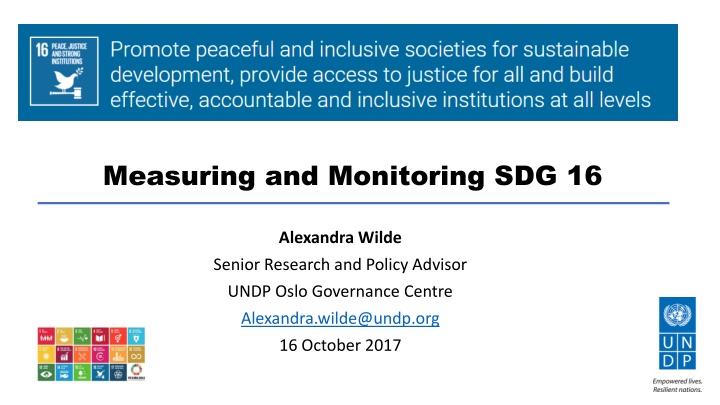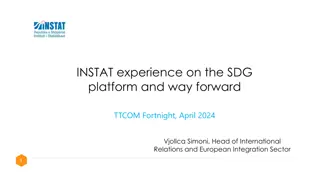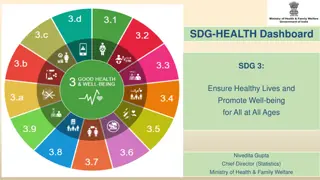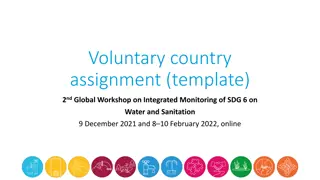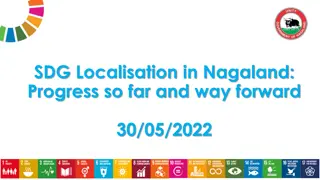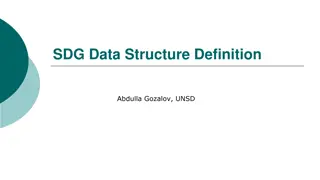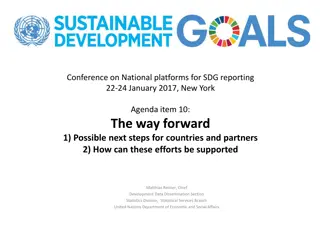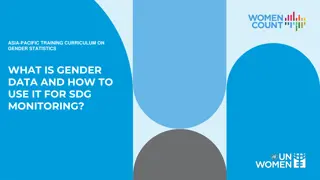Measuring and Monitoring SDG 16: Challenges and Comprehensive Approach
The article discusses the importance of SDG 16 in creating peaceful, just, and inclusive societies for sustainable development. It highlights the challenges in measuring and monitoring SDG 16, such as complex concepts and contested indicators, along with the need for comprehensive interconnected approaches. The focus is on leveraging data from various sources, integrating citizen-generated data, and addressing interlinkages.
Download Presentation

Please find below an Image/Link to download the presentation.
The content on the website is provided AS IS for your information and personal use only. It may not be sold, licensed, or shared on other websites without obtaining consent from the author.If you encounter any issues during the download, it is possible that the publisher has removed the file from their server.
You are allowed to download the files provided on this website for personal or commercial use, subject to the condition that they are used lawfully. All files are the property of their respective owners.
The content on the website is provided AS IS for your information and personal use only. It may not be sold, licensed, or shared on other websites without obtaining consent from the author.
E N D
Presentation Transcript
Measuring and Monitoring SDG 16 Alexandra Wilde Senior Research and Policy Advisor UNDP Oslo Governance Centre Alexandra.wilde@undp.org 16 October 2017
SDG 16 SDG 16 why does it matter? why does it matter? Lessons from the MDGs peaceful, just, inclusive societies key for sustainable development My World : honest and effective government high priority SDG 16 important aspiration in its own right and an important enabling goal Strong links with other goals, in line with the indivisible nature of Agenda 2030 Cross cutting SDG similar to SDGs 5 (gender equality), 10 (reduced inequalities); 13 (climate change) and 17 (partnerships)
Challenges for measuring and monitoring SDG 16 Complex concepts difficult to define and measure but can be done and is being done 7 tier 3 indicators perceptions, experience, events Highly contested indicators (even in technical spaces) Poor admin data and expensive surveys (investment, innovations, partnerships of data stakeholders) Opening up for non-official sources data integrating third party data into official statistics that meet statistical standards including citizen centric measures/citizen generated data Monitoring approaches that address interlinkages/integration and learning Balance for global reporting on same indicators vs contextualised SDG implementation and monitoring plans
Comprehensive interconnected approach Comprehensive interconnected approach Goal 16 + Goal 16 + 16.1 Violence 16.2 Violence ag. children Illicit fin fkows and org crime 16.6 16.3 RoL, A2J 16.6 Institutions 16.4 Institutions 16.5 Corruption Illicit fin flows and org crime 16.4 16.9 16.A Int. Institut. Leg. identity Just 4.7 16.5 Corruption 16.A Int. institutions 4.5 Peaceful societies Ed on HR & GE societies Discr. education 5.C 5.1 Policies for GE 4.7 5.4 Discr. Women & girls Education for peace Violence against women and girls 8.5 5.3 Equal pay Fem. gen mutilation 8.7 8.8 10.7 Child soldiers, slavery 16.6 Labour rights 10.4 Policies for equality 16.7 10.3 Safe migration 11.7 Safe urban spaces 16.4 Institutions Participation Equal opport. Illicit fin fkows and org crime 16.5 Corruption 16.3 RoL, A2J 16.8 Part in global inst. Inclusive societies 16.10 16.9 A2I & freedoms 5.5 Women leadership Leg. identity 1.A Inst >< poverty 10.2 Inclusion 10.7 Migration pol 10.3 17.10 Equitable trade 17.1 Fair taxation Incl. urbanisation
Principles for SDG 16 national monitoring Principles for SDG 16 national monitoring frameworks frameworks Nationally owned data sovereignty/country led data Global National: Indicators should be contextualized, nationalized and localized. Strengthen local capacities for data and statistics production and dissemination Leaving no-one behind: indicator methodologies that capture and include marginalised and vulnerable groups but also by location/geography need to unmask subnational variations. Disaggregation: disaggregated by sex, age, geography, income, race, ethnicity, migratory status, disability, and other characteristics relevant in national contexts. Innovation and partnership with non-traditional data stakeholders
National processes for monitoring Goal 16 National processes for monitoring Goal 16 International level complementary indicators (i.e. SDG 16 Data Initiative, CoD) Official national level indicators Global SDG indicators Stage 1. Collection of Indicators Analytical joint reviews of progress and recommendations (consultation rounds) Stage 2. Joint Analytical Review and Narrative Assessments Thematic cluster working group Thematic cluster working group Thematic cluster working group Thematic cluster working group Stage 3. Country Specific Periodic Scorecard Monitor Data Gaps Country Specific Periodic Scorecard National Develp t Plans Policy Options 7
Early implementers Early implementers 8
Report Card for SDG 16 Report Card for SDG 16 Report card with traffic light system has been agreed as monetoring mechanism as it opens for qualitative assessment Target 16.7. Ensure responsive, inclusive, participatory and representative decision- making at all levels Target Indicator 16.7.2a: Democratic Institutions Index Indicator 16.7.2b. Civil Liberties Index Indicator 16.7.2c. Political Rights Index 2011 47.54 2012 46.33 2013 46.25 2014 63.72 2015 66.87 80.79 77.94 79 82.62 80.3 Objectives: To identify the status of activities, on/off track To measure performance of process To estimate achievement of programme / activities 74.72 69.28 72.24 75.81 70.63 Narrative Assessment What is working? Challenges in Implementation? What are the bottle necks? Responsible Implementers? Summary and Way Forwards Recommendation and Next Step How is it working? Commitments 9
Implications of measuring and monitoring SDG 16 for strengthening national evaluation capacities Engagement in the VNR development process to complement with qualitative evidence on progress Contribute through evaluation to understand interlinkages of SDG 16 targets with other goals Evaluations to contribute to informing the selection of national indicators Contribute to understanding the performance of SDG 16 global indicators at national level (to inform also the global indicator review)
Thank you! Thank you!
